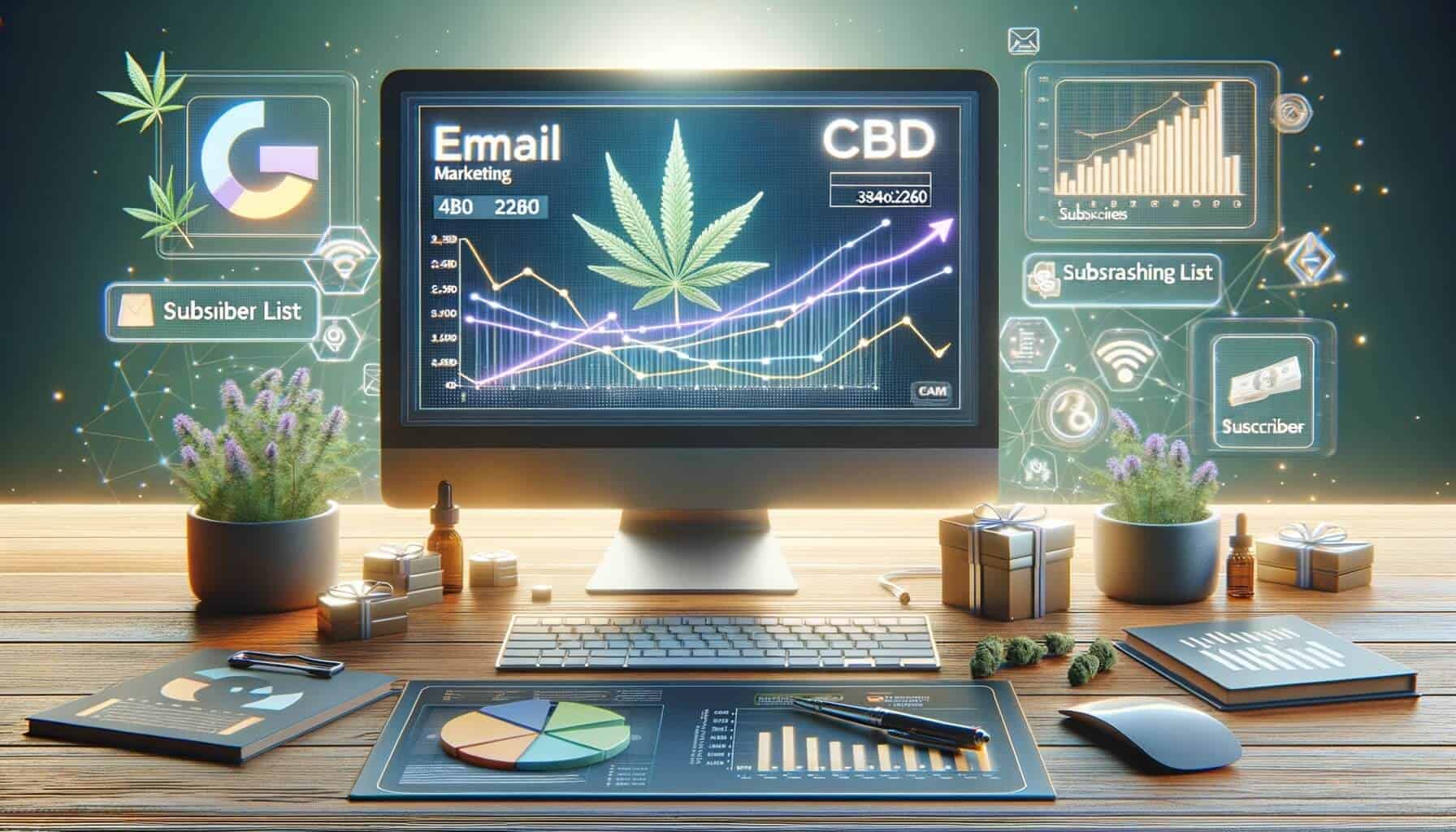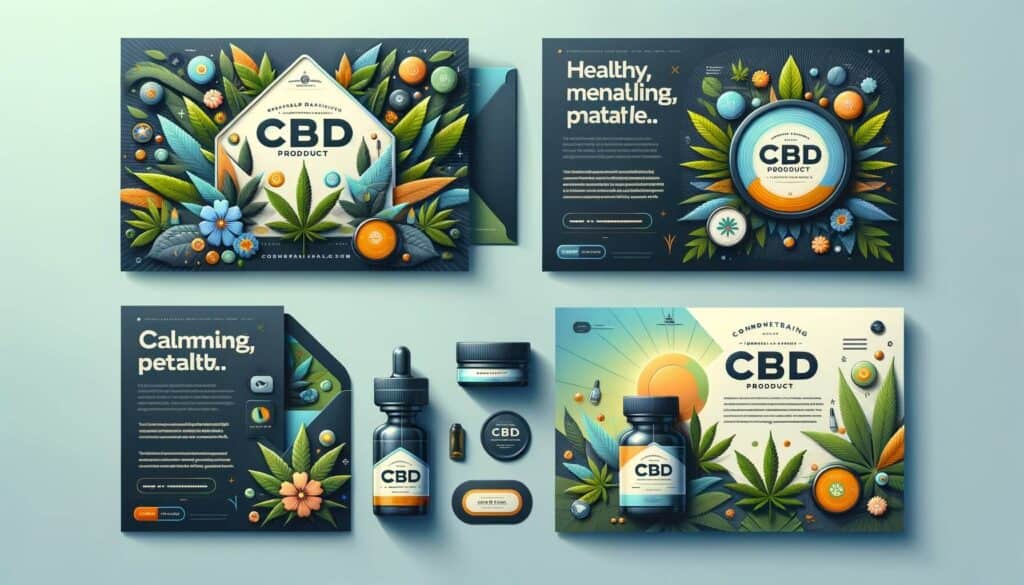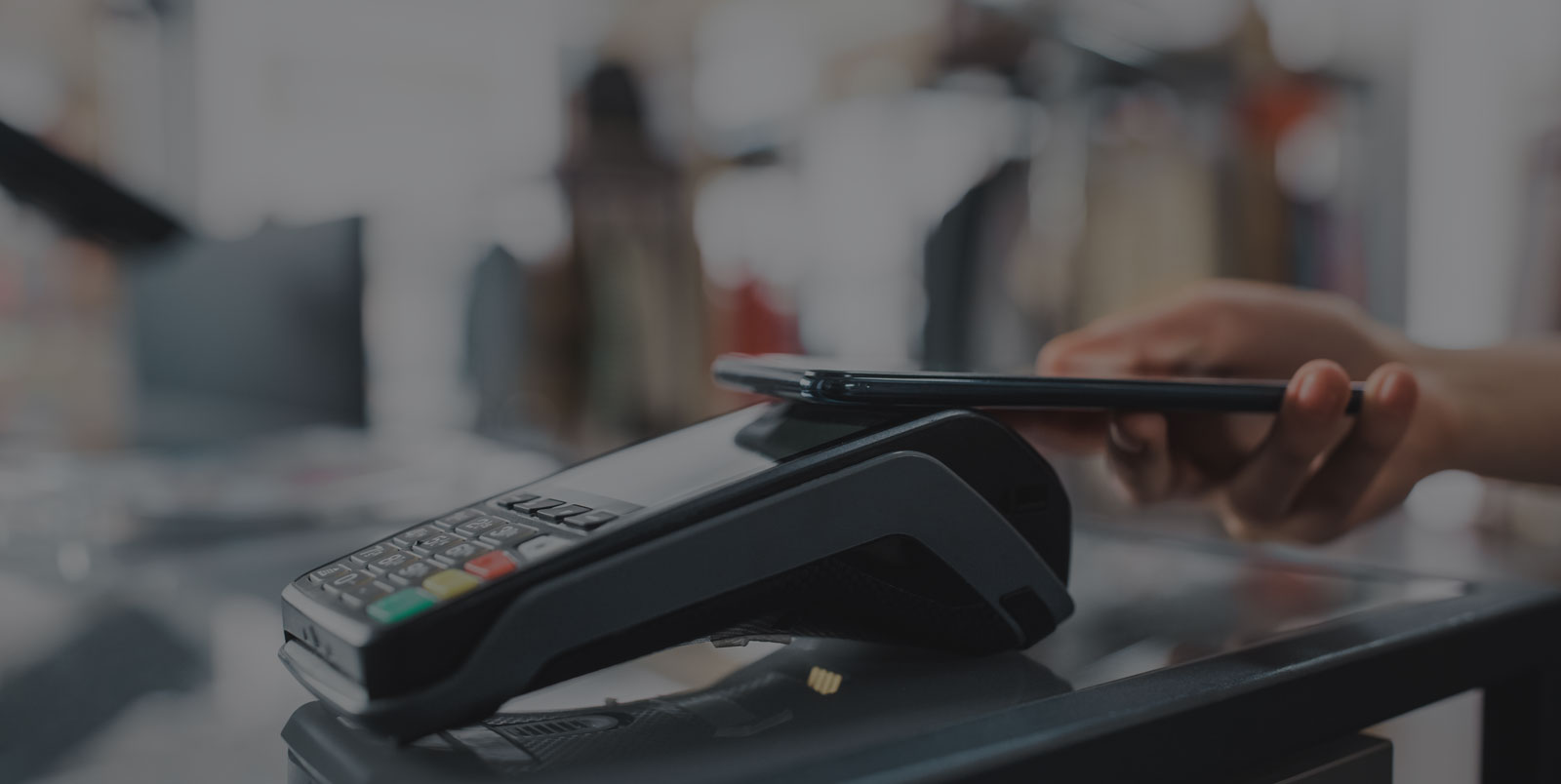
By Mia Leach January 14, 2025
Email marketing has become an essential tool for businesses across various industries, and the CBD industry is no exception. With the increasing popularity and acceptance of CBD products, it is crucial for CBD businesses to leverage effective marketing strategies to stand out in a competitive market. Email marketing offers a cost-effective and efficient way to reach and engage with potential customers, build brand loyalty, and drive sales.
In this comprehensive guide, we will explore the benefits of email marketing for CBD businesses and provide a detailed roadmap for implementing successful email campaigns.
Understanding the Potential of Email Marketing in the CBD Industry

The CBD industry has experienced exponential growth in recent years, with consumers seeking natural alternatives for various health and wellness needs. According to a report by Grand View Research, the global CBD market size is expected to reach $13.4 billion by 2028. With such immense potential, CBD businesses need to adopt effective marketing strategies to capitalize on this growing market. Email marketing offers a unique opportunity to connect with customers directly, build relationships, and drive conversions.
One of the key advantages of email marketing is its high return on investment (ROI). According to the Data & Marketing Association, email marketing has an average ROI of $42 for every $1 spent. This makes it one of the most cost-effective marketing channels for CBD businesses, especially for those operating on a limited budget. Additionally, email marketing allows businesses to target specific customer segments, personalize content, and track campaign performance, enabling them to optimize their marketing efforts and achieve better results.
Building an Effective Email List for CBD Businesses

The foundation of a successful email marketing campaign is a high-quality email list. Building an email list for CBD businesses requires a strategic approach to ensure that the subscribers are genuinely interested in the products or services being offered. Here are some effective strategies for building an email list for CBD businesses:
1. Opt-in Forms: Place opt-in forms prominently on your website, allowing visitors to subscribe to your email list. Offer incentives such as exclusive discounts or informative content to encourage sign-ups.
2. Content Upgrades: Create valuable content related to CBD, such as e-books, guides, or educational videos, and offer them as content upgrades in exchange for email addresses.
3. Social Media Promotion: Leverage your social media presence to promote your email list. Encourage followers to sign up by highlighting the benefits they will receive, such as exclusive offers or early access to new products.
4. Co-marketing Partnerships: Collaborate with complementary businesses in the health and wellness industry to cross-promote each other’s email lists. This can help expand your reach and attract new subscribers.
5. Events and Trade Shows: Collect email addresses at industry events and trade shows by offering a prize draw or exclusive event updates to those who sign up.
6. Referral Programs: Implement a referral program where existing subscribers can earn rewards or discounts for referring friends and family to join your email list.
Crafting Compelling Email Content for CBD Customers

Once you have built a solid email list, the next step is to create compelling content that resonates with your CBD customers. The content of your emails should be informative, engaging, and relevant to your audience’s needs and interests. Here are some tips for crafting compelling email content for CBD customers:
1. Personalization: Use personalization techniques to address subscribers by their name and tailor the content based on their preferences and purchase history. This helps create a personalized experience and increases engagement.
2. Educational Content: Provide valuable information about CBD, its benefits, and usage tips. Educating your customers builds trust and positions your brand as an authority in the industry.
3. Product Updates and Launches: Keep your subscribers informed about new product releases, special promotions, and limited-time offers. Exclusive access to new products can create a sense of urgency and drive sales.
4. Customer Testimonials: Share success stories and testimonials from satisfied customers to build social proof and instill confidence in your products.
5. User-Generated Content: Encourage customers to share their experiences with your products and feature their content in your emails. This not only adds authenticity but also encourages engagement and loyalty.
6. Seasonal and Holiday Campaigns: Create themed campaigns around holidays or seasons to offer special discounts or promotions. This can help drive sales and create a sense of excitement among your subscribers.
7. Educational Newsletters: Send regular newsletters with curated content related to CBD, health, and wellness. This positions your brand as a trusted source of information and keeps your subscribers engaged.
8. Surveys and Feedback Requests: Ask for feedback from your subscribers to understand their preferences, needs, and pain points. This valuable insight can help you tailor your products and marketing strategies to better serve your customers.
9. Abandoned Cart Reminders: Implement automated emails to remind customers who have abandoned their carts to complete their purchase. Offer incentives such as discounts or free shipping to encourage conversion.
10. Exclusive Offers and Rewards: Reward your loyal subscribers with exclusive offers, discounts, or early access to new products. This helps foster a sense of loyalty and encourages repeat purchases.
Designing Eye-Catching Email Templates for CBD Campaigns

The design of your email templates plays a crucial role in capturing the attention of your subscribers and conveying your brand’s message effectively. Here are some best practices for designing eye-catching email templates for CBD campaigns:
1. Mobile-Friendly Design: With the majority of emails being opened on mobile devices, it is essential to ensure that your email templates are optimized for mobile viewing. Use responsive design techniques to adapt the layout and font sizes for different screen sizes.
2. Clear and Concise Layout: Keep your email layout clean and uncluttered, with a clear hierarchy of information. Use headings, subheadings, and bullet points to make the content scannable and easy to read.
3. Brand Consistency: Use your brand colors, fonts, and logo consistently across all your email templates. This helps reinforce brand recognition and creates a cohesive brand experience.
4. Compelling Subject Lines: Craft attention-grabbing subject lines that entice subscribers to open your emails. Use personalization, urgency, or curiosity to pique their interest.
5. Engaging Visuals: Incorporate high-quality images, videos, or GIFs that are relevant to your content. Visuals can help break up the text and make your emails more visually appealing.
6. Call-to-Action Buttons: Use clear and prominent call-to-action (CTA) buttons that stand out from the rest of the content. Use action-oriented language and compelling copy to encourage clicks.
7. Social Media Integration: Include social media icons in your email templates to encourage subscribers to follow and engage with your brand on social platforms. This helps expand your reach and build a community around your brand.
8. A/B Testing: Experiment with different design elements, such as colors, layouts, or CTA button placement, to optimize your email templates. Conduct A/B tests to determine which design variations perform better and generate higher engagement.
Implementing Email Automation for CBD Business Growth
Email automation is a powerful tool that allows CBD businesses to streamline their marketing efforts, save time, and deliver personalized experiences to their subscribers. Here are some key ways to implement email automation for CBD business growth:
1. Welcome Series: Set up a series of automated emails to welcome new subscribers and introduce them to your brand. Use this opportunity to provide valuable information about your products, share customer testimonials, and offer exclusive discounts.
2. Abandoned Cart Emails: Implement automated emails to remind customers who have abandoned their carts to complete their purchase. Include a clear CTA button and offer incentives to encourage conversion.
3. Drip Campaigns: Create automated drip campaigns that deliver a series of emails over a specific period. This can be used to nurture leads, educate subscribers about CBD, or promote specific products or services.
4. Birthday and Anniversary Emails: Send personalized emails to subscribers on their birthdays or anniversaries with exclusive offers or discounts. This helps foster a sense of loyalty and makes customers feel valued.
5. Re-engagement Campaigns: Identify subscribers who have become inactive or haven’t engaged with your emails for a certain period. Set up automated re-engagement campaigns to win them back by offering incentives or asking for feedback.
6. Post-Purchase Follow-ups: Send automated emails to customers after they make a purchase to thank them for their support, request product reviews, and offer recommendations for related products.
7. Upsell and Cross-sell Campaigns: Use automation to identify opportunities for upselling or cross-selling based on customers’ purchase history. Send targeted emails with personalized product recommendations to encourage additional purchases.
8. Customer Journey Automation: Map out the customer journey and identify key touchpoints where automated emails can be triggered. This ensures that customers receive relevant and timely emails based on their interactions with your brand.
Analyzing Email Marketing Metrics for CBD Success
To measure the success of your email marketing campaigns and make data-driven decisions, it is essential to analyze key metrics. Here are some important email marketing metrics for CBD businesses:
1. Open Rate: The open rate measures the percentage of subscribers who open your emails. A high open rate indicates that your subject lines are compelling and resonate with your audience.
2. Click-through Rate (CTR): The CTR measures the percentage of subscribers who click on a link or CTA button in your email. A high CTR indicates that your content and CTAs are engaging and persuasive.
3. Conversion Rate: The conversion rate measures the percentage of subscribers who complete a desired action, such as making a purchase or filling out a form. Tracking the conversion rate helps evaluate the effectiveness of your email campaigns in driving sales or achieving specific goals.
4. Bounce Rate: The bounce rate measures the percentage of emails that were not delivered to the recipient’s inbox. A high bounce rate may indicate issues with your email list quality or deliverability.
5. Unsubscribe Rate: The unsubscribe rate measures the percentage of subscribers who opt-out of your email list. Monitoring the unsubscribe rate helps identify potential issues with your content, frequency, or targeting.
6. Revenue per Email: This metric calculates the average revenue generated per email sent. It helps evaluate the overall effectiveness of your email campaigns in driving sales and generating revenue.
7. List Growth Rate: The list growth rate measures the rate at which your email list is growing. Tracking this metric helps assess the success of your list-building strategies and the overall health of your email marketing efforts.
8. Spam Complaint Rate: The spam complaint rate measures the percentage of subscribers who mark your emails as spam. A high spam complaint rate can negatively impact your deliverability and sender reputation.
Leveraging Personalization and Segmentation in CBD Email Campaigns
Personalization and segmentation are powerful techniques that can significantly enhance the effectiveness of your CBD email campaigns. By tailoring your content and offers to specific customer segments, you can deliver more relevant and engaging experiences. Here are some strategies for leveraging personalization and segmentation in CBD email campaigns:
1. Demographic Segmentation: Segment your email list based on demographic factors such as age, gender, location, or income level. This allows you to create targeted campaigns that resonate with specific customer groups.
2. Purchase History Segmentation: Segment your email list based on customers’ past purchase behavior. This enables you to send personalized product recommendations, upsell or cross-sell offers, and exclusive discounts based on their preferences.
3. Behavioral Segmentation: Segment your email list based on subscribers’ interactions with your emails or website. For example, you can create segments for subscribers who have clicked on specific links, abandoned carts, or engaged with certain types of content. This allows you to send targeted emails that align with their interests and behaviors.
4. Personalized Recommendations: Use data from customers’ purchase history or browsing behavior to offer personalized product recommendations. This helps increase relevance and encourages repeat purchases.
5. Dynamic Content: Implement dynamic content in your emails to display personalized information based on subscribers’ attributes or behaviors. For example, you can show different product recommendations based on customers’ preferences or display location-specific offers.
6. Triggered Emails: Set up triggered emails that are automatically sent based on specific actions or events. For example, you can send a personalized follow-up email after a customer makes a purchase or a reminder email when a product is back in stock.
7. Personalized Subject Lines: Use personalization techniques in your subject lines to grab subscribers’ attention and increase open rates. Incorporate their name, location, or past purchase history to make the emails feel more personalized.
8. Dynamic Segmentation: Continuously analyze and update your segments based on subscribers’ behaviors and preferences. This ensures that your emails remain relevant and targeted over time.
Overcoming Challenges and Compliance Issues in CBD Email Marketing
While email marketing offers numerous benefits for CBD businesses, there are also unique challenges and compliance issues that need to be addressed. Due to the legal and regulatory landscape surrounding CBD products, it is crucial to navigate these challenges carefully. Here are some common challenges and compliance issues in CBD email marketing and strategies to overcome them:
1. Legal Compliance: CBD businesses need to ensure that their email marketing practices comply with local, state, and federal laws. Familiarize yourself with the regulations governing CBD marketing, including restrictions on health claims, age restrictions, and labeling requirements.
2. Email Service Provider Restrictions: Some email service providers have restrictions or guidelines specific to CBD businesses. Before choosing an email service provider, ensure that they allow CBD-related content and comply with your specific needs.
3. Content Restrictions: Be mindful of the content you include in your emails to avoid making unsubstantiated health claims or violating any regulations. Focus on providing educational information, testimonials, and product updates without making any medical or therapeutic claims.
4. List Hygiene: Maintain a clean and healthy email list by regularly removing inactive or unengaged subscribers. This helps improve deliverability and ensures that your emails reach the intended audience.
5. Deliverability Challenges: Due to the nature of the CBD industry, some email service providers may categorize CBD-related emails as high-risk or spam. Implement best practices for email deliverability, such as using double opt-in, authenticating your domain, and monitoring your sender reputation.
6. Privacy and Data Protection: Ensure that you comply with privacy and data protection regulations, such as the General Data Protection Regulation (GDPR) in the European Union. Obtain explicit consent from subscribers before collecting and using their personal information.
7. Customer Education: Educate your customers about the benefits and uses of CBD products to dispel any misconceptions or concerns. Provide accurate and transparent information to build trust and credibility.
8. Customer Support: Offer responsive customer support to address any questions or concerns raised by your subscribers. Promptly address any issues related to product quality, shipping, or customer experience to maintain a positive brand reputation.
FAQs
Q.1: Can CBD businesses legally use email marketing?
Yes, CBD businesses can legally use email marketing as long as they comply with relevant laws and regulations, such as obtaining consent from subscribers and providing an option to unsubscribe.
Q.2: How often should CBD businesses send emails to their subscribers?
The frequency of email campaigns may vary depending on the specific business and audience. However, it is generally recommended to strike a balance between staying top-of-mind and avoiding overwhelming subscribers. Testing different frequencies and monitoring engagement metrics can help determine the optimal sending frequency.
Q.3: How can CBD businesses ensure their emails are delivered to the inbox and not the spam folder?
To improve email deliverability, CBD businesses should follow best practices such as using a reputable email service provider, authenticating their domain, avoiding spam trigger words, and regularly cleaning their email list.
Q.4: Can email marketing help CBD businesses build brand loyalty?
Yes, email marketing is an effective tool for building brand loyalty. By consistently delivering valuable content, personalized offers, and exclusive promotions, CBD businesses can foster a strong connection with their subscribers and keep them engaged with the brand.
Conclusion
Email marketing is a powerful tool for CBD businesses to connect with their target audience, build brand loyalty, and drive sales. By understanding the potential of email marketing in the CBD industry and implementing effective strategies, businesses can overcome marketing challenges and achieve success.
Building an email list, crafting compelling content, designing eye-catching templates, implementing automation, and analyzing metrics are all essential components of a successful email marketing campaign. By following the guidelines outlined in this comprehensive guide, CBD businesses can leverage the power of email marketing to grow their business and thrive in the competitive CBD industry.
